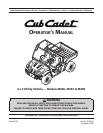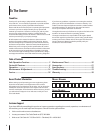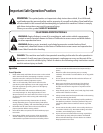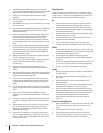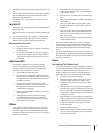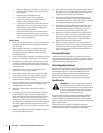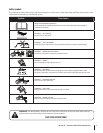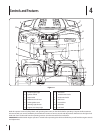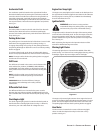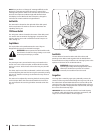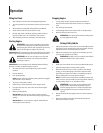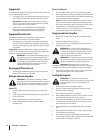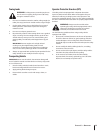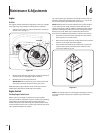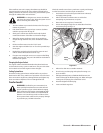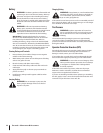
4 se c t i O n 2 — iM p O r ta n t sa f e Op e r a t i O n pr a c t i c e s
Avoid driving through water, since loss of control may 16.
occur. Drive belt may slip if exposed to water thus reducing
vehicle pulling power and stopping vehicle entirely.
Always use vehicle lights while operating in low light 17.
situations.
Do not mount or leave vehicle while it is in motion or in 18.
actual operation.
Avoid sudden starts, stops, or turns and always use a level 19.
turn-around area.
Never leave vehicle unattended with the key in the ignition. 20.
Always turn key to the “Stop” position, set the parking
brake and remove key.
Check overhead clearances carefully before driving under 21.
low hanging tree branches, wires, power lines, bridges,
before entering or leaving buildings, or in any other
situation where the operator and/or operator protective
structure (OPS) may be struck, which could result in serious
injury.
Use the operator protective structure (OPS) and seat belt 22.
for safe operation. Overturning the utility vehicle without
a operator protective structure (OPS), or with a operator
protective structure (OPS) and the seat belt unfastened,
can result in death or injury.
Always use the seat belt, except if the operator protective 23.
structure (OPS) has been removed.
Improper use of the vehicle or failure to properly maintain 24.
it could result in decreased vehicle performance or
personal injury.
Engine must be stopped when cleaning, servicing, 25.
adjusting, repairing, or installing attachments on utility
vehicle.
After striking foreign objects, stop the unit and shut off the 26.
engine. Inspect for damage and repair the damage before
restarting and operating equipment.
Do not start or operate vehicle in an inside area, unless it 27.
is adequately ventilated. Engine exhaust contains carbon
monoxide fumes, which are very poisonous and can be
deadly.
Do not change engine governor setting or over speed the 28.
engine. The governor is set at the factory for safe operating
speed.
Assure safety interlock switch is adjusted correctly so 29.
engine cannot be started unless gearshift is in the neutral
position.
Do not touch engine or muffler while engine is running or 30.
soon after it is stopped. They will be hot and can cause a
burn.
Always inspect your vehicle each time you use it to make 31.
sure it is in safe operating condition. Always follow the
inspection and maintenance procedures and schedules
described in this manual.
If situations occur which are not covered in this manual, 32.
use care and good judgement. Contact your local service
center or call toll free 1-877-282-8684 for the name of your
nearest service center.
Slope Operation
Slopes are a major factor related to loss of control and rollover
accidents, which can result in severe injury or death. If a slope is
steeper than a 15° incline, do not operate this unit on that area.
Exercise extreme caution while operating on slopes.
Do:
Travel straight up and down slopes, not across. Exercise 1.
extreme caution when changing direction on slopes.
Travel slowly while on a slope. Always keep the forward 2.
speed limited when going down slopes to take advantage
of the motor braking action.
Keep all movement on the slopes slow and gradual. Avoid 3.
starting or stopping on a slope.
Avoid slopes with slippery, loose, or bumpy surfaces as 4.
they are especially hazardous.
Use extra care while carrying cargo. It may affect the 5.
stability of the vehicle. Spread the load evenly or tie down.
Do Not:
Do not travel near drop-offs, ditches or embankments. The 1.
vehicle could suddenly turn over if a wheel is over the edge
of a cliff, ditch, or if an edge caves in.
Do not stop or start suddenly when going uphill or 2.
downhill. Be especially cautious when changing direction
on slopes.
Do not turn sideways to the hill. The vehicle may roll over. If 3.
you must turn, go slow and do so carefully and gradually.
Do not carry cargo on steep slopes or tow loads.4.
Towing
Always use an approved hitch and hitch point provided on 1.
the utility vehicle.
Do not tow more than 1400 lbs. rolling weight (i.e. trailer 2.
plus cargo).
Never load more than 140 lbs. tongue weight on tow 3.
bracket provided.
Go slow and use extra care when towing a trailer. Allow for 4.
increased braking distance. Load trailer properly.
Do not tow heavy loads on slopes greater than 5° incline. 5.
When going downhill or turning, the extra weight tends to
push the tow vehicle and may cause you to loose control
(i.e. braking and steering ability are reduced, towed
equipment may jack-knife and cause utility vehicle to
overturn).
Cargo Box Loading/Operation
Do not exceed vehicle’s Total Load Capacity rating of 1,400 1.
lbs. This includes operator, passenger, accessories, and
cargo.
Do not exceed 1000 lbs. load in cargo box.2.
Spread load evenly and secure to prevent movement.3.
Do not load above height of cargo box front panel. Load 4.
could shift forward and injure driver or passenger.



